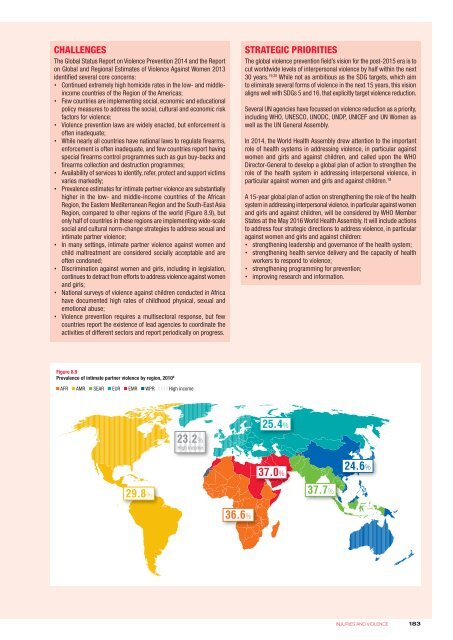Create successful ePaper yourself
Turn your PDF publications into a flip-book with our unique Google optimized e-Paper software.
CHALLENGES<br />
The Global Status Report on Violence Prevention 2014 and the Report<br />
on Global and Regional Estimates of Violence Against Women 2013<br />
identified several core concerns:<br />
• Continued extremely high homicide rates in the low- and middleincome<br />
countries of the Region of the Americas;<br />
• Few countries are implementing social, economic and educational<br />
policy measures <strong>to</strong> address the social, cultural and economic risk<br />
fac<strong>to</strong>rs for violence;<br />
• Violence prevention laws are widely enacted, but enforcement is<br />
often inadequate;<br />
• While nearly all countries have national laws <strong>to</strong> regulate firearms,<br />
enforcement is often inadequate, and few countries report having<br />
special firearms control programmes such as gun buy-backs and<br />
firearms collection and destruction programmes;<br />
• Availability of services <strong>to</strong> identify, refer, protect and support victims<br />
varies markedly;<br />
• Prevalence estimates for intimate partner violence are substantially<br />
higher in the low- and middle-income countries of the African<br />
Region, the Eastern Mediterranean Region and the South-East Asia<br />
Region, compared <strong>to</strong> other regions of the world (Figure 8.9), but<br />
only half of countries in these regions are implementing wide-scale<br />
social and cultural norm-change strategies <strong>to</strong> address sexual and<br />
intimate partner violence;<br />
• In many settings, intimate partner violence against women and<br />
child maltreatment are considered socially acceptable and are<br />
often condoned;<br />
• Discrimination against women and girls, including in legislation,<br />
continues <strong>to</strong> detract <strong>from</strong> efforts <strong>to</strong> address violence against women<br />
and girls;<br />
• National surveys of violence against children conducted in Africa<br />
have documented high rates of childhood physical, sexual and<br />
emotional abuse;<br />
• Violence prevention requires a multisec<strong>to</strong>ral response, but few<br />
countries report the existence of lead agencies <strong>to</strong> coordinate the<br />
activities of different sec<strong>to</strong>rs and report periodically on progress.<br />
STRATEGIC PRIORITIES<br />
The global violence prevention field’s vision for the post-2015 era is <strong>to</strong><br />
cut worldwide levels of interpersonal violence by half within the next<br />
30 years. 19,20 While not as ambitious as the SDG targets, which aim<br />
<strong>to</strong> eliminate several forms of violence in the next 15 years, this vision<br />
aligns well with SDGs 5 and 16, that explicitly target violence reduction.<br />
Several UN agencies have focussed on violence reduction as a priority,<br />
including WHO, UNESCO, UNODC, UNDP, UNICEF and UN Women as<br />
well as the UN General Assembly.<br />
In 2014, the World Health Assembly drew attention <strong>to</strong> the important<br />
role of health systems in addressing violence, in particular against<br />
women and girls and against children, and called upon the WHO<br />
Direc<strong>to</strong>r-General <strong>to</strong> develop a global plan of action <strong>to</strong> strengthen the<br />
role of the health system in addressing interpersonal violence, in<br />
particular against women and girls and against children. 18<br />
A 15-year global plan of action on strengthening the role of the health<br />
system in addressing interpersonal violence, in particular against women<br />
and girls and against children, will be considered by WHO Member<br />
States at the May 2016 World Health Assembly. It will include actions<br />
<strong>to</strong> address four strategic directions <strong>to</strong> address violence, in particular<br />
against women and girls and against children:<br />
• strengthening leadership and governance of the health system;<br />
• strengthening health service delivery and the capacity of health<br />
workers <strong>to</strong> respond <strong>to</strong> violence;<br />
• strengthening programming for prevention;<br />
• improving research and information.<br />
Figure 8.9<br />
Prevalence of intimate partner violence by region, 2010 8<br />
AFR AMR SEAR EUR EMR WPR High income<br />
23.2%<br />
High income<br />
25.4%<br />
37.0%<br />
24.6%<br />
29.8% 37.7%<br />
36.6%<br />
INJURIES AND VIOLENCE<br />
183


